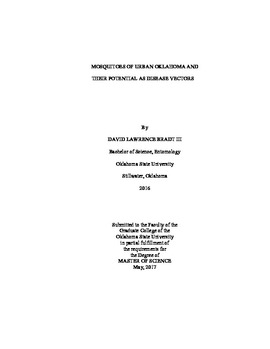| dc.description.abstract | The mosquito diversity of Oklahoma was last evaluated in a series of surveys conducted between 2003 and 2006 and before that, the previous survey was in 1965. Prior surveys targeted specific questions including the evaluation of West Nile virus. However, a systematic survey of the cities in Oklahoma was not conducted. In this study, mosquito populations were surveyed approximately bi-weekly at six different cities, including four with military bases, in central and southeastern Oklahoma between May and September 2016. Three different traps were used: CDC Mini Light traps with lights removed and baited with dry ice, CDC Gravid traps baited with Bermuda grass-conditioned water, and BG-Sentinel� traps baited with BG lure. A total of 11,980 adult female mosquitoes representing 34 species were collected over 834 trapping events. Mosquito communities differed significantly among trap type, with CDC Mini Light traps collecting the most individuals. Mosquito communities also differed significantly among cities sampled. These results show that urban areas in Oklahoma do not possess a homogenous mosquito community, and each city should be evaluated individually (at least within the same climate region). Aedes aegypti, an important disease vector was recorded in Oklahoma for the first time since 1940. Eighty-eight specimens of Ae. aegypti were collected in the cities of Altus, Ardmore, Frederick, and Lawton. CDC Mini Light traps were more attractive to Ae. aegypti than other two trap types. The most abundant mosquito species: Ae. albopictus, Ae. sollicitans, Ae. triseriatus, Cx. pipiens, and Cx. tarsalis were tested for presence of Dirolfilaria immitis, the causative agent for dog heartworm, and other parasitic nematodes. One mosquito pool tested was PCR positive for D. immitis, from a Cx. pipiens pool. Six other nematodes were collected in pools from Ae. albopictus. The D. immitis positive pool was collected from Idabel, OK, while four other positive pools were collected from Ardmore, OK, and one from Midwest City, OK. The information generated from this study provides insight into mosquito populations and potential for nematode transmission in Oklahoma. With increases in human populations living in cities, movement of people and global climate change, the results of this study serves as a baseline and informs mosquito management strategies for southern Oklahoma. | |
